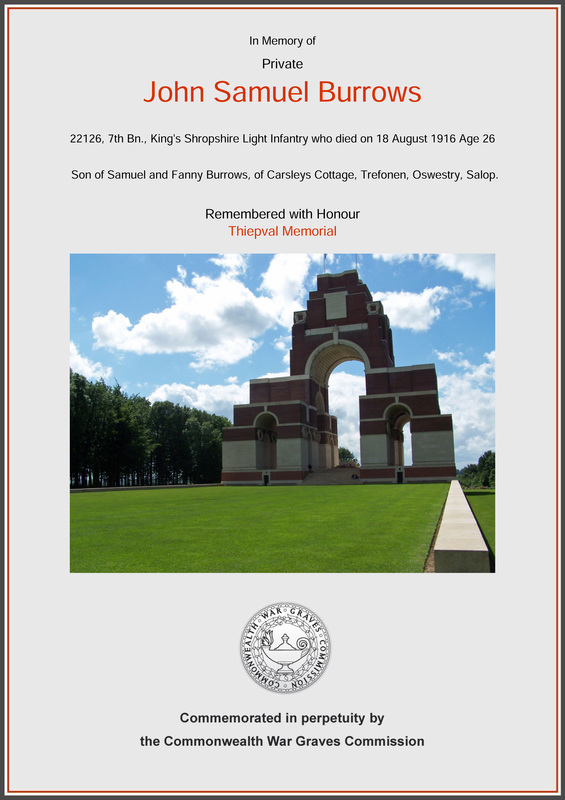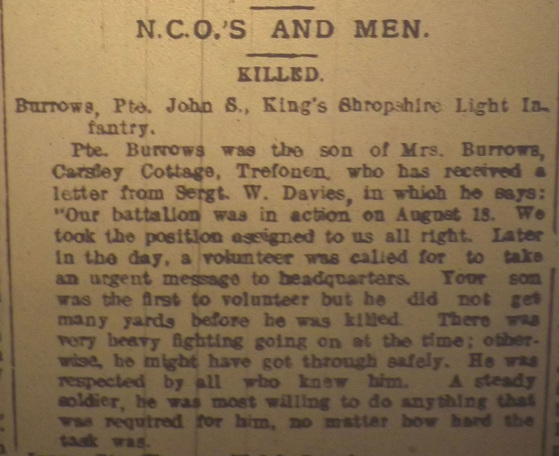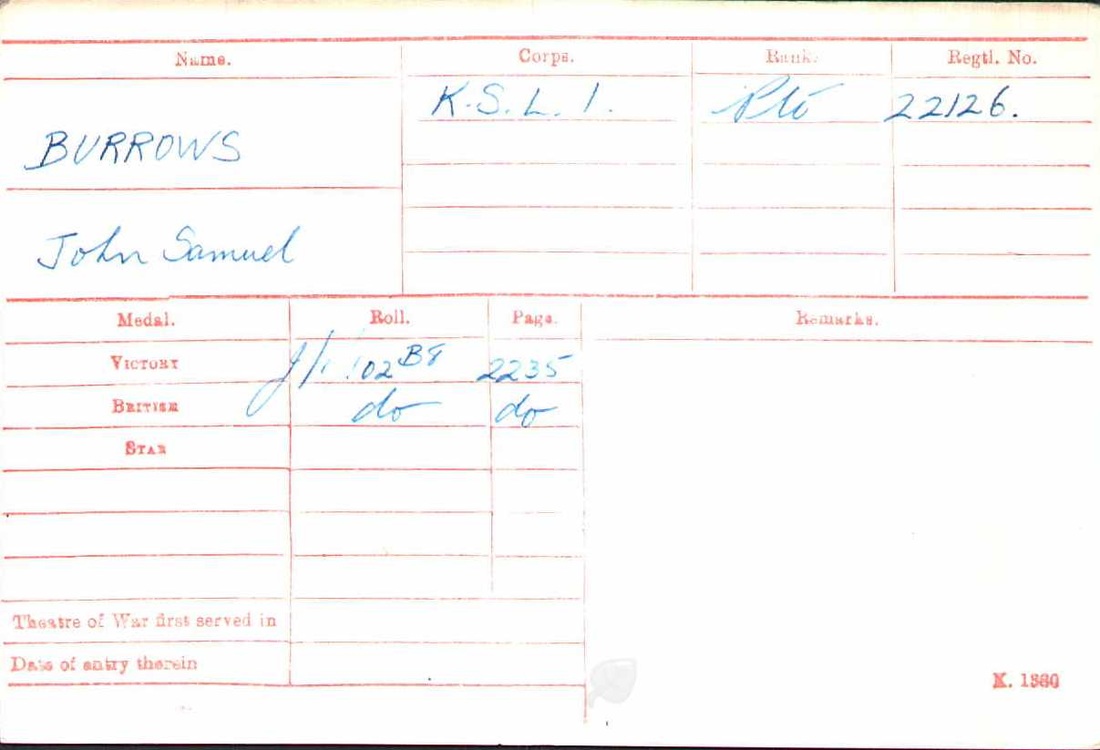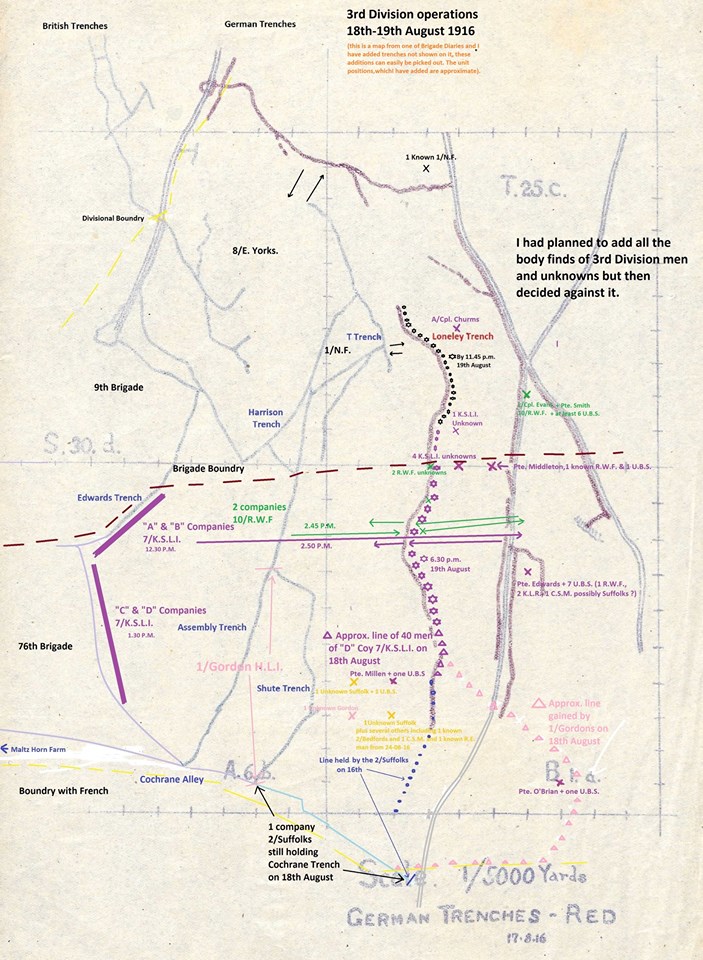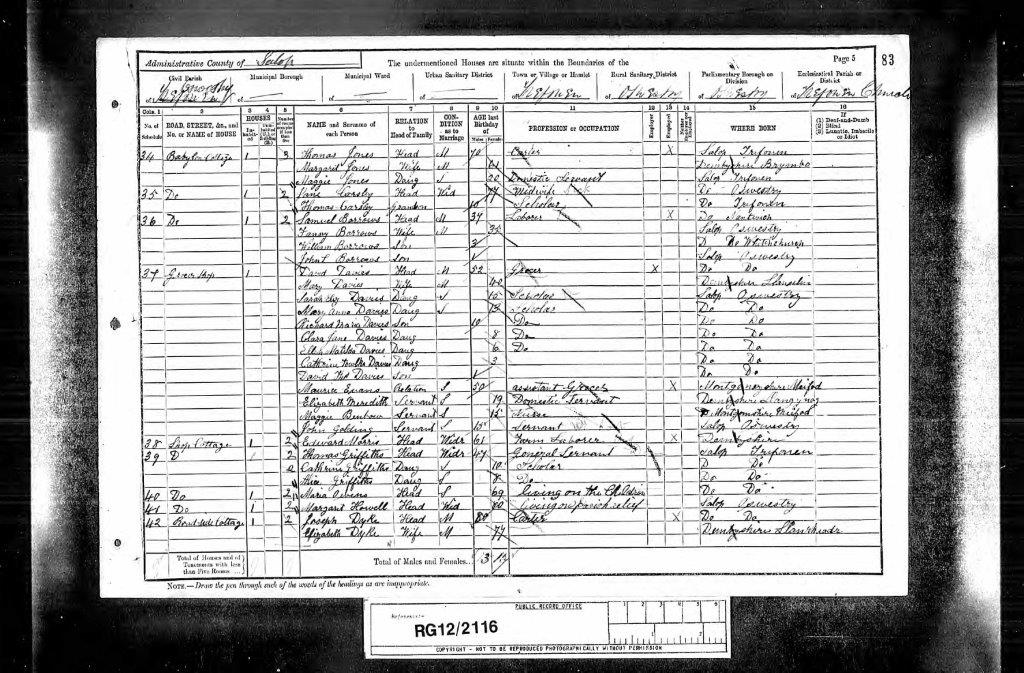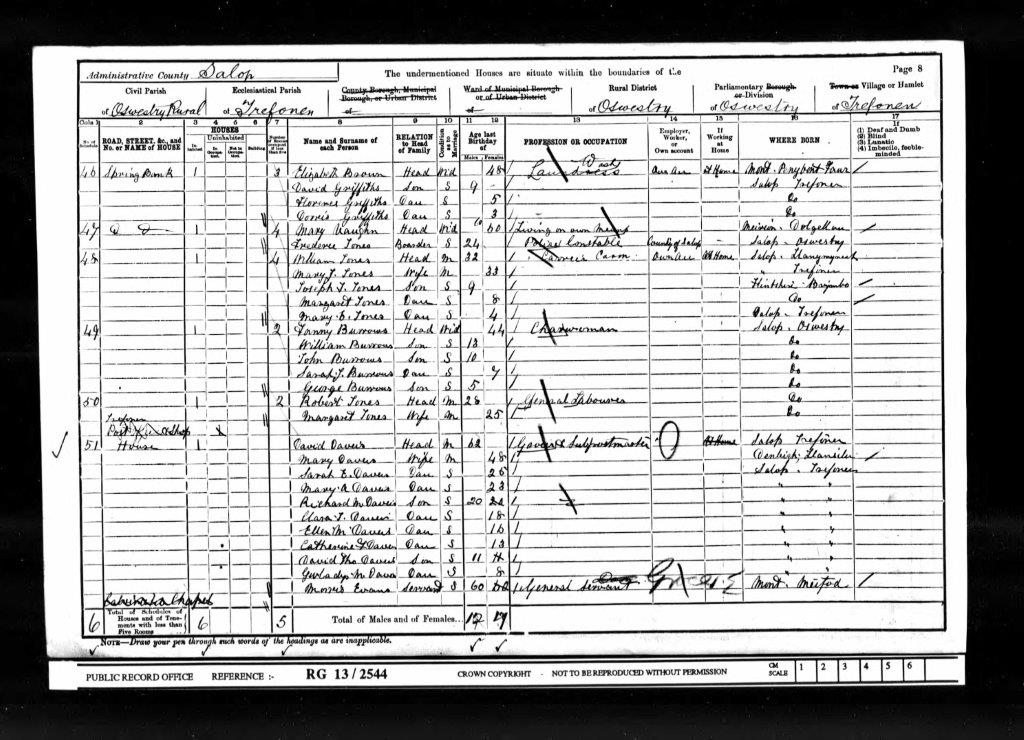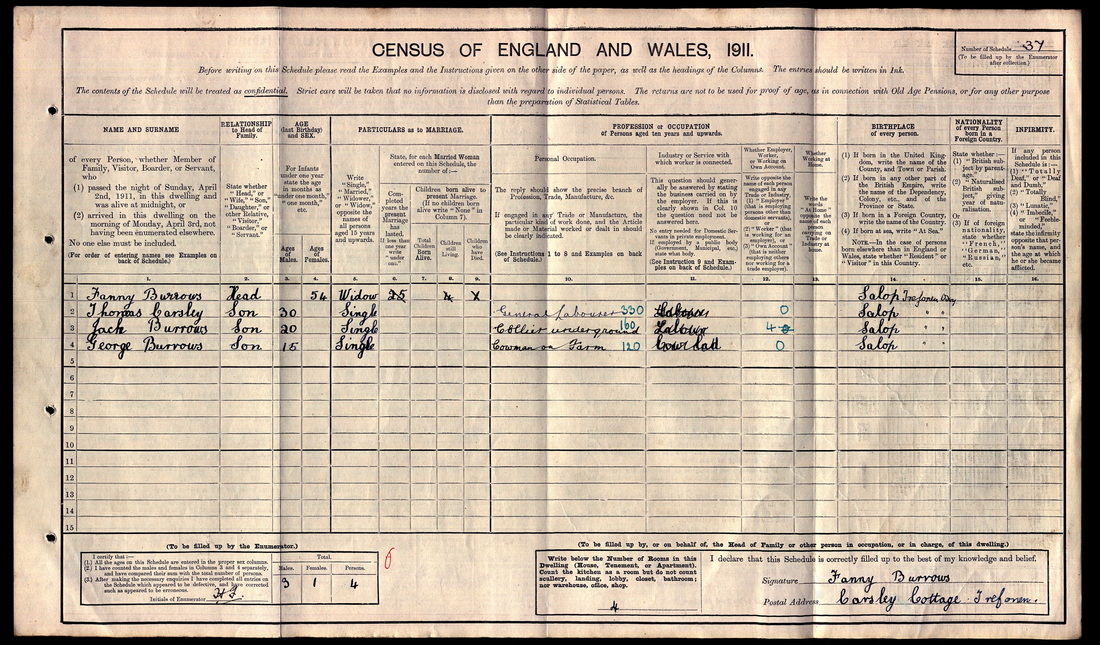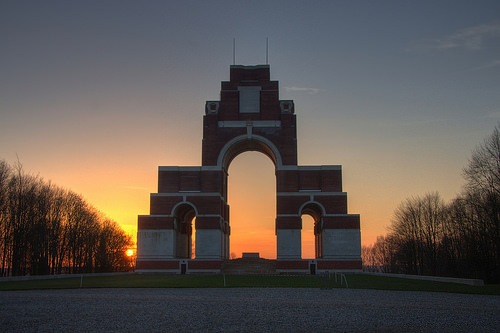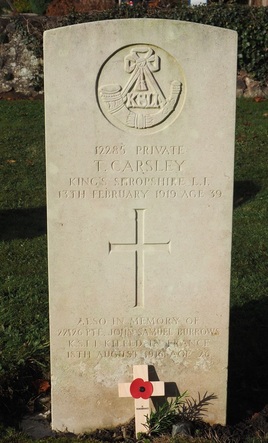John Samuel Burrows
Military Record including Regimental and Battalion Information
There is very little information as to when and where John Samuel Burrows enlisted but it is thought he enlisted in Oswestry and was assigned to the 7th Battalion Kings Shropshire Light Infantry who were mobilised on 12th or 13th February 1916. His medal roll index card does not show when he first entered the theatre of war but it is thought that he arrived in France in early May 1916. The 7th KSLI first saw action in the Ypres Salient in the winter of 1915-16 and moved to the Somme in July 1916; fought at Bazentin Ridge and then at Serre on the Ancre later in the year.
A report on Private Burrows death and the circumstances surrounding it were recorded in the Border Counties Advertizer below.
There is very little information as to when and where John Samuel Burrows enlisted but it is thought he enlisted in Oswestry and was assigned to the 7th Battalion Kings Shropshire Light Infantry who were mobilised on 12th or 13th February 1916. His medal roll index card does not show when he first entered the theatre of war but it is thought that he arrived in France in early May 1916. The 7th KSLI first saw action in the Ypres Salient in the winter of 1915-16 and moved to the Somme in July 1916; fought at Bazentin Ridge and then at Serre on the Ancre later in the year.
A report on Private Burrows death and the circumstances surrounding it were recorded in the Border Counties Advertizer below.
The following extract is taken from the 7th Battalions War Diary and put together by Annette Burgoyne who's site www.facebook.com/KSLI.Battlefields.tours/ is a daily updated Facebook site regarding the KSLI and World War One. Annette has kindly allowed me to use her report below regarding the battalions movements on the day John Samuel Burrows was killed.
The 7th Battalion King's Shropshire Light Infantry-Talus Bois, south of Montauban, Somme:-
The 9th & 76th Brigades tried take Lonely Trench again at 4 a.m. but again it failed and the troops returned to British line. As many wounded as possible were removed from No Mans Land.
The 7/K.S.L.I. received orders to move to the 76th Brigades H.Q. Maltz Horn Farm, and came under their orders, also the 8/East Yorks, were placed under orders of the 9th Brigade.
The 9th and 76th Brigade would be making another attack later that day, east of Maltz Horn Farm, with the 8th Brigade were in support, in conjunction with the 24th Division on the left and the 153rd French Division on the right.
The 7/K.S.L.I.'s Commanding Officer, and company commanders at once proceeded to the 76th Brigade H.Q. and then reconnoitre the ground from the French Line, who were on the right of the 76th Brigade, and who are slightly more advanced. The main body of the Battalion set off at about 5.30 a.m. and make their way to Chimpanzee Trench.
The 1/Gordon Highlanders relieved the 2/Suffolks on the right of the line, the remnants of the two companies of the Suffolks in Cochrane Alley remained in this trench, and were to act as reserve to the Gordons (I am not sure if they still hold line B.1.a.2.0 & B.1.a.3.4. that they captured on 16th). The Bombardment on Loneley Trench started at 9 a.m. and would continued until 1 p.m.
In the mean time at 12.30 p.m. “A” and “B” companies 7/K.S.L.I. moved up to Edwards Trench, and were place in support of the 10/R.W.F., who were on the left, with 1/Gordon Highlanders on their right. At 1.30 p.m. “C” and “D” companies were moved to a Trench between Edwards Trench and Cochrane Alley, behind the 1/Gordon Highlanders.
The first objective was the Guillemont – Hardecourt road, and Lonely Trench was to be taken in the first bound. Zero hour, was 2.45 p.m. the 10/R.W.F. soon captured the southern part of Lonely Trench but the 9th Brigade on their left failed to progress due to very heavy machine gun fire from the northern part of Lonely Trench, some parties of the 8/East Yorks on the left did get in the trench in places but due to heavy German shell fire (the Germans were quick at letting the their artillery known that British troops were in their trench) had to get out leaving the northern part of the trench in German hands. The 9th Brigade were also hampered throughout the day by British artillery firing on their line, many messages had been sent back which stopped the fire but nearly every time the British artillery covering the 9th Brigade opened up shells fell on British held trenches.
“A” and “B” companies of the 7/K.S.L.I. reinforced the 10/R.W.F. at 2.50 p.m. and helped capture the line of the road; the 1/Gordons also captured their part of the road. How ever the 10/R.W.F. and 7/K.S.L.I. troops were forced to withdraw from the road but held their part of Lonely Trench for a while, there was much uncertainty at Brigade H.Q. throughout the evening as to whether Loneley Trench was held or not, but it was abandoned at some point before the day was out.
The Gordons managed to held on to their gains, and were in touch with the French, who had also advanced and managed to take part of Maltz Horn Ravine.
The second phase of the attack should have started at 4.25 p.m. but owing to the first phase only being partially successful, it called off.
During the evening the line of the 76th Brigade and the French on the right were heavily shelled and the Germans managed to push the French back. Some of the Gordons (on right only) were involved in this withdrawal. “D” Company of the 7th K.S.L.I. were sent to the left of the Gordons (about 40 K.S.L.I. and about 200 Gordons consolidated about 450 yards of the of captured position). The K.S.L.I. companies already in the line (presumably holding shell holes on the Royal Welch Fusiliers front) set about connecting the shell holes up to form a good fire trench. The Battalion suffered 130 casualties, 42 of these were killed (possibly one these was killed on the 19th ?).
It is known one officer was wounded on this day.
The 7th Battalion King's Shropshire Light Infantry-Talus Bois, south of Montauban, Somme:-
The 9th & 76th Brigades tried take Lonely Trench again at 4 a.m. but again it failed and the troops returned to British line. As many wounded as possible were removed from No Mans Land.
The 7/K.S.L.I. received orders to move to the 76th Brigades H.Q. Maltz Horn Farm, and came under their orders, also the 8/East Yorks, were placed under orders of the 9th Brigade.
The 9th and 76th Brigade would be making another attack later that day, east of Maltz Horn Farm, with the 8th Brigade were in support, in conjunction with the 24th Division on the left and the 153rd French Division on the right.
The 7/K.S.L.I.'s Commanding Officer, and company commanders at once proceeded to the 76th Brigade H.Q. and then reconnoitre the ground from the French Line, who were on the right of the 76th Brigade, and who are slightly more advanced. The main body of the Battalion set off at about 5.30 a.m. and make their way to Chimpanzee Trench.
The 1/Gordon Highlanders relieved the 2/Suffolks on the right of the line, the remnants of the two companies of the Suffolks in Cochrane Alley remained in this trench, and were to act as reserve to the Gordons (I am not sure if they still hold line B.1.a.2.0 & B.1.a.3.4. that they captured on 16th). The Bombardment on Loneley Trench started at 9 a.m. and would continued until 1 p.m.
In the mean time at 12.30 p.m. “A” and “B” companies 7/K.S.L.I. moved up to Edwards Trench, and were place in support of the 10/R.W.F., who were on the left, with 1/Gordon Highlanders on their right. At 1.30 p.m. “C” and “D” companies were moved to a Trench between Edwards Trench and Cochrane Alley, behind the 1/Gordon Highlanders.
The first objective was the Guillemont – Hardecourt road, and Lonely Trench was to be taken in the first bound. Zero hour, was 2.45 p.m. the 10/R.W.F. soon captured the southern part of Lonely Trench but the 9th Brigade on their left failed to progress due to very heavy machine gun fire from the northern part of Lonely Trench, some parties of the 8/East Yorks on the left did get in the trench in places but due to heavy German shell fire (the Germans were quick at letting the their artillery known that British troops were in their trench) had to get out leaving the northern part of the trench in German hands. The 9th Brigade were also hampered throughout the day by British artillery firing on their line, many messages had been sent back which stopped the fire but nearly every time the British artillery covering the 9th Brigade opened up shells fell on British held trenches.
“A” and “B” companies of the 7/K.S.L.I. reinforced the 10/R.W.F. at 2.50 p.m. and helped capture the line of the road; the 1/Gordons also captured their part of the road. How ever the 10/R.W.F. and 7/K.S.L.I. troops were forced to withdraw from the road but held their part of Lonely Trench for a while, there was much uncertainty at Brigade H.Q. throughout the evening as to whether Loneley Trench was held or not, but it was abandoned at some point before the day was out.
The Gordons managed to held on to their gains, and were in touch with the French, who had also advanced and managed to take part of Maltz Horn Ravine.
The second phase of the attack should have started at 4.25 p.m. but owing to the first phase only being partially successful, it called off.
During the evening the line of the 76th Brigade and the French on the right were heavily shelled and the Germans managed to push the French back. Some of the Gordons (on right only) were involved in this withdrawal. “D” Company of the 7th K.S.L.I. were sent to the left of the Gordons (about 40 K.S.L.I. and about 200 Gordons consolidated about 450 yards of the of captured position). The K.S.L.I. companies already in the line (presumably holding shell holes on the Royal Welch Fusiliers front) set about connecting the shell holes up to form a good fire trench. The Battalion suffered 130 casualties, 42 of these were killed (possibly one these was killed on the 19th ?).
It is known one officer was wounded on this day.
Census data
In the census data it would appear that John Samuel Burrows was known as Jack in the 1911 census. We have drawn this conclusion having looked at the 1891 and 1901 census where he is called John Samuel
In the census data it would appear that John Samuel Burrows was known as Jack in the 1911 census. We have drawn this conclusion having looked at the 1891 and 1901 census where he is called John Samuel
Historical Information
On 1 July 1916, supported by a French attack to the south, thirteen divisions of Commonwealth forces launched an offensive on a line from north of Gommecourt to Maricourt. Despite a preliminary bombardment lasting seven days, the German defences were barely touched and the attack met unexpectedly fierce resistance. Losses were catastrophic and with only minimal advances on the southern flank, the initial attack was a failure. In the following weeks, huge resources of manpower and equipment were deployed in an attempt to exploit the modest successes of the first day. However, the German Army resisted tenaciously and repeated attacks and counter attacks meant a major battle for every village, copse and farmhouse gained. At the end of September, Thiepval was finally captured. The village had been an original objective of 1 July. Attacks north and east continued throughout October and into November in increasingly difficult weather conditions. The Battle of the Somme finally ended on 18 November with the onset of winter.
In the spring of 1917, the German forces fell back to their newly prepared defences, the Hindenburg Line, and there were no further significant engagements in the Somme sector until the Germans mounted their major offensive in March 1918.
The Thiepval Memorial, the Memorial to the Missing of the Somme, bears the names of more than 72,000 officers and men of the United Kingdom and South African forces who died in the Somme sector before 20 March 1918 and have no known grave. Over 90% of those commemorated died between July and November 1916. The memorial also serves as an Anglo-French Battle Memorial in recognition of the joint nature of the 1916 offensive and a small cemetery containing equal numbers of Commonwealth and French graves lies at the foot of the memorial.
The memorial, designed by Sir Edwin Lutyens, was built between 1928 and 1932 and unveiled by the Prince of Wales, in the presence of the President of France, on 1 August 1932 (originally scheduled for 16 May but due to the death of French President Doumer the ceremony was postponed until August).
The dead of other Commonwealth countries, who died on the Somme and have no known graves, are commemorated on national memorials elsewhere.
click on the link below for more information
www.cwgc.org/find-a-cemetery/cemetery/80800/THIEPVAL%20MEMORIAL
On 1 July 1916, supported by a French attack to the south, thirteen divisions of Commonwealth forces launched an offensive on a line from north of Gommecourt to Maricourt. Despite a preliminary bombardment lasting seven days, the German defences were barely touched and the attack met unexpectedly fierce resistance. Losses were catastrophic and with only minimal advances on the southern flank, the initial attack was a failure. In the following weeks, huge resources of manpower and equipment were deployed in an attempt to exploit the modest successes of the first day. However, the German Army resisted tenaciously and repeated attacks and counter attacks meant a major battle for every village, copse and farmhouse gained. At the end of September, Thiepval was finally captured. The village had been an original objective of 1 July. Attacks north and east continued throughout October and into November in increasingly difficult weather conditions. The Battle of the Somme finally ended on 18 November with the onset of winter.
In the spring of 1917, the German forces fell back to their newly prepared defences, the Hindenburg Line, and there were no further significant engagements in the Somme sector until the Germans mounted their major offensive in March 1918.
The Thiepval Memorial, the Memorial to the Missing of the Somme, bears the names of more than 72,000 officers and men of the United Kingdom and South African forces who died in the Somme sector before 20 March 1918 and have no known grave. Over 90% of those commemorated died between July and November 1916. The memorial also serves as an Anglo-French Battle Memorial in recognition of the joint nature of the 1916 offensive and a small cemetery containing equal numbers of Commonwealth and French graves lies at the foot of the memorial.
The memorial, designed by Sir Edwin Lutyens, was built between 1928 and 1932 and unveiled by the Prince of Wales, in the presence of the President of France, on 1 August 1932 (originally scheduled for 16 May but due to the death of French President Doumer the ceremony was postponed until August).
The dead of other Commonwealth countries, who died on the Somme and have no known graves, are commemorated on national memorials elsewhere.
click on the link below for more information
www.cwgc.org/find-a-cemetery/cemetery/80800/THIEPVAL%20MEMORIAL
